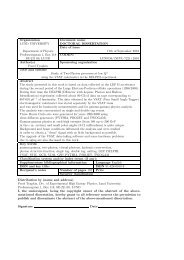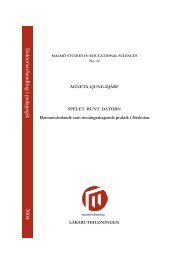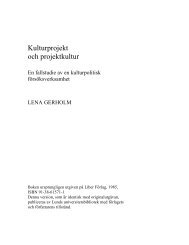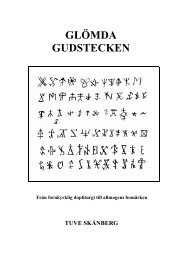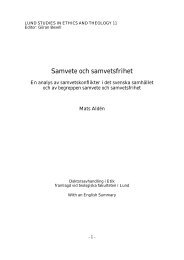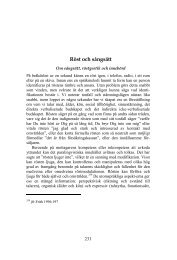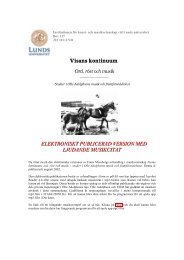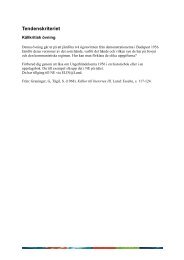Hyperpolarized Nuclei for NMR Imaging and Spectroscopy - Lunds ...
Hyperpolarized Nuclei for NMR Imaging and Spectroscopy - Lunds ...
Hyperpolarized Nuclei for NMR Imaging and Spectroscopy - Lunds ...
Create successful ePaper yourself
Turn your PDF publications into a flip-book with our unique Google optimized e-Paper software.
3 Methods<br />
3.1 Hyperpolarization equipment<br />
Three hyperpolarized nuclei were investigated in this thesis: the noble gases<br />
129 Xe (Papers I <strong>and</strong> V) <strong>and</strong> 3 He (Papers III <strong>and</strong> IV), <strong>and</strong> a liquid 13 C substance<br />
(Paper II). The noble gases were polarized by means of optical<br />
pumping, whereas a different principle (DNP) was used <strong>for</strong> polarization of<br />
13 C (see section 2.2).<br />
3.1.1 Polarization <strong>and</strong> h<strong>and</strong>ling of 3 He <strong>and</strong> 129 Xe<br />
129 Xe was polarized using a prototype commercial polarizer (IGI. 9800, Amersham<br />
Health, Durham, NC, USA). In this system, a continuously flowing<br />
gas mixture at ∼5 bar pressure (1% 129 Xe, 10% N 2, <strong>and</strong> 89% 4 He) passes an<br />
optical cell containing ∼1 g of Rb. When the cell is heated to 160–180 °C,<br />
small amounts of Rb evaporate <strong>and</strong> get optically pumped by a circularly polarized<br />
795-nm laser beam illuminating the cell. Via collisions between Xe<br />
<strong>and</strong> Rb, the polarization of the Rb electrons is transferred to the Xe nuclei.<br />
After leaving the optical cell, the gas mixture passes a cold-finger trap, cooled<br />
by liquid nitrogen, where the hyperpolarized 129 Xe is frozen, while the other<br />
gases are ventilated out into the atmosphere. When a sufficient amount of<br />
Xe has accumulated (typically within half an hour), the cold finger is rapidly<br />
heated with water <strong>and</strong> the thawed Xe is dispensed into a reservoir.<br />
Another prototype commercial polarizer (IGI. 9600, Amersham Health)<br />
was used <strong>for</strong> polarization of 3 He. Similar to the Xe polarizer, an optical cell<br />
containing Rb is heated to 160–180 °C <strong>and</strong> illuminated with a 795-nm circularly<br />
polarized laser beam, but the gas mixture (99% 3 He, 1% N 2) is filled<br />
into the cell once <strong>and</strong> remains inside the closed cell during the polarization<br />
procedure. The optical cell is pressurized to ∼9 bar, corresponding to a hyperpolarized<br />
gas volume of ∼1.1 liter at atmospheric pressure. The polarization<br />
process usually runs overnight (typically during 15–18 h).<br />
Once sufficient polarization levels were reached, both the 129 Xe <strong>and</strong> the<br />
3 He gas were dispensed into a plastic bag (Tedlar ® , Jensen Inert, Coral<br />
Springs, FL, USA) with low surface relaxation rate <strong>and</strong> transported ∼40 m<br />
from the polarizer to the MRI scanner (duration of transport less than<br />
5 min). Using a dedicated measurement equipment (Amersham Health), the<br />
actual polarization level in the Tedlar bag was determined be<strong>for</strong>e <strong>and</strong> after<br />
the <strong>NMR</strong> experiments. The measurement principle is based on the detec-<br />
24



